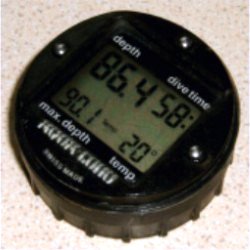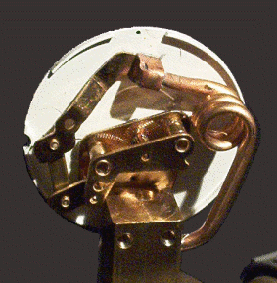Depth gauge
Depth gauge is a tool used for measuring the depth of an object or a hole. This instrument plays a crucial role in various fields such as engineering, woodworking, metalworking, and diving. Depth gauges come in different forms, including vernier, dial, and digital types, each serving specific measurement needs and accuracy levels.
Types of Depth Gauges[edit | edit source]
Vernier Depth Gauge[edit | edit source]
The Vernier depth gauge is a precision tool that allows for fine measurements. It consists of a main scale and a sliding vernier scale, which together enable users to read measurements to a higher degree of accuracy. This type of gauge is commonly used in machining and manufacturing for quality control.
Dial Depth Gauge[edit | edit source]
A Dial depth gauge features a dial display that shows the depth measurement. It is easier to read compared to the vernier type and is suitable for applications where speed is more critical than extreme precision. Dial depth gauges are often used in automotive and construction industries.
Digital Depth Gauge[edit | edit source]
The Digital depth gauge offers the most straightforward reading through an electronic display. This type of gauge is known for its ease of use and high accuracy. Digital depth gauges are widely used across various industries, including woodworking, metalworking, and even in laboratories.
Diving Depth Gauge[edit | edit source]
In diving, a depth gauge is an essential piece of safety equipment. It helps divers monitor their depth underwater to manage decompression times and avoid decompression sickness. Modern diving computers often integrate a depth gauge with other critical information such as dive time and ascent rate.
Applications[edit | edit source]
Depth gauges are indispensable in many industrial and recreational activities. In engineering and manufacturing, they ensure that components meet specified dimensions for proper assembly and function. In woodworking and metalworking, depth gauges help achieve precise cuts and bores. For divers, they are vital for monitoring depth to ensure safety under water.
Accuracy and Calibration[edit | edit source]
The accuracy of a depth gauge depends on its type and quality. Regular calibration is essential to maintain precision, especially for tools used in quality control and safety-critical applications. Calibration involves comparing the readings of a depth gauge with a standard of known accuracy and making adjustments as necessary.
Search WikiMD
Ad.Tired of being Overweight? Try W8MD's physician weight loss program.
Semaglutide (Ozempic / Wegovy and Tirzepatide (Mounjaro / Zepbound) available.
Advertise on WikiMD
|
WikiMD's Wellness Encyclopedia |
| Let Food Be Thy Medicine Medicine Thy Food - Hippocrates |
Translate this page: - East Asian
中文,
日本,
한국어,
South Asian
हिन्दी,
தமிழ்,
తెలుగు,
Urdu,
ಕನ್ನಡ,
Southeast Asian
Indonesian,
Vietnamese,
Thai,
မြန်မာဘာသာ,
বাংলা
European
español,
Deutsch,
français,
Greek,
português do Brasil,
polski,
română,
русский,
Nederlands,
norsk,
svenska,
suomi,
Italian
Middle Eastern & African
عربى,
Turkish,
Persian,
Hebrew,
Afrikaans,
isiZulu,
Kiswahili,
Other
Bulgarian,
Hungarian,
Czech,
Swedish,
മലയാളം,
मराठी,
ਪੰਜਾਬੀ,
ગુજરાતી,
Portuguese,
Ukrainian
Medical Disclaimer: WikiMD is not a substitute for professional medical advice. The information on WikiMD is provided as an information resource only, may be incorrect, outdated or misleading, and is not to be used or relied on for any diagnostic or treatment purposes. Please consult your health care provider before making any healthcare decisions or for guidance about a specific medical condition. WikiMD expressly disclaims responsibility, and shall have no liability, for any damages, loss, injury, or liability whatsoever suffered as a result of your reliance on the information contained in this site. By visiting this site you agree to the foregoing terms and conditions, which may from time to time be changed or supplemented by WikiMD. If you do not agree to the foregoing terms and conditions, you should not enter or use this site. See full disclaimer.
Credits:Most images are courtesy of Wikimedia commons, and templates, categories Wikipedia, licensed under CC BY SA or similar.
Contributors: Prab R. Tumpati, MD




